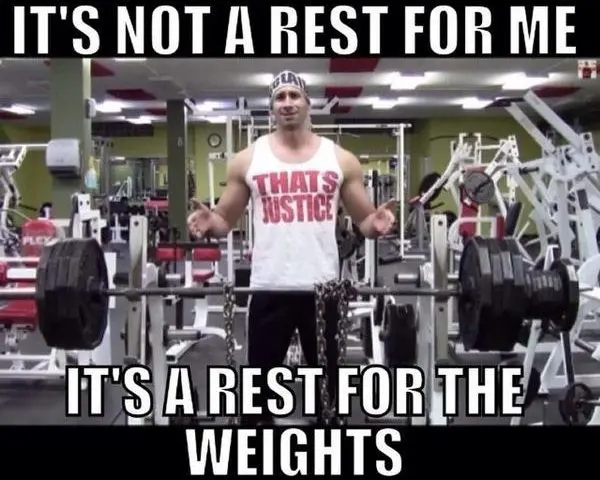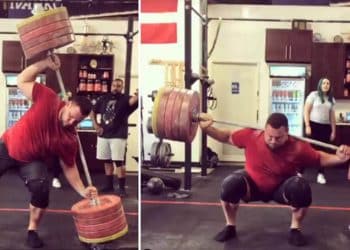Take a look around your gym. Check out the muscle size and strength of your fellow exercisers. Now cast your mind back a year. How many of them are significantly bigger or stronger today than they were 12 months ago?
It’s a good bet that most of them haven’t changed at all. All those workouts, supplements, and all that effort has produced literally zero progress!
Now, consider your own results. Are you moving forward, or have you stalled too?
Progress ruts are very common. A lot of exercisers make plenty of progress early on in their training and then see no changes for months or even years at a time. The thing is that they THINK they are training hard, but in reality, they are working out at the same level of intensity week after week, month after month, and year after year.
They’re working just hard enough to maintain their current muscle mass and strength. But, if you want to keep making progress, you need to apply the principle of progressive overload to your workouts. This means you need to train harder this week than you did last week, and you need to train harder next month you did this month.
To avoid training ruts, you should change your workout every 4-8 weeks or whenever you notice that your progress is starting to stall. Also, during the life of your current program, you should endeavor to increase the intensity of your workout from one week to the next.
Level Up Your Fitness: Join our 💪 strong community in Fitness Volt Newsletter. Get daily inspiration, expert-backed workouts, nutrition tips, the latest in strength sports, and the support you need to reach your goals. Subscribe for free!
Here are the TEN best ways to make any exercise harder, and therefore more effective.
1. Increase the weight
The most common way to make an exercise harder is to use more weight. This method is good for building both muscle size and strength. However, there are a few downsides to relying solely on weight increases for progress, which is why it’s useful to have some alternatives.
- Strength increases are often smaller than the lowest available weight denomination. For example, you might gain a kilo in strength, but the next weight increase is five or even ten kilos if you are using a machine.
- Adding too much weight too fast can cause poor form and injuries.
- Focusing on weight can lead to ego-lifting. Unless you are a weightlifter or powerlifter, the amount of weight is not as important as the effect it has on your muscles.
- It’s hard to increase the weight with bodyweight exercises.
- You’ll soon stall using this method.
If you do use weight increases to make your workout more demanding and effective, you should use small increments and never sacrifice good exercise form for more pounds on the bar.
Also, be aware that strength increases are rarely linear. You might be able to increase your weights by five pounds per week for a month, but then only two pounds per week after that. A few weeks later, your progress will come to a stop, and you’ll unable to increase your weights at all. At that point, it’s time to switch to another method or change your workout.
2. Do more reps
A lot of exercisers have a favorite rep count they gravitate toward. They’ll do the same number of reps per set whenever they workout out. If you always do the same number of reps, and especially if your weights remain constant, you are probably in a workout and progress rut.
Doing more reps will obviously make your workout harder, providing you keep your weights the same that is.
Instead of randomly increasing your reps, use a more structured progression to maintain your progress. For example:
- Week one – 8, 8, 8 (three sets of eight reps)
- Week two – 9, 8, 8 (one set of nine reps, and two sets of eight reps)
- Week three – 9, 9, 8 (two sets of nine reps, and one set of eight reps)
- Week four – 9, 9, 9 (three sets of nine reps)
- Week five 10, 9, 9 (one set of ten reps, and two sets of nine reps)
- Week six – 10, 10, 9 (two sets of ten reps, and one set of nine reps)
- Week seven – 10, 10, 10 (three sets of ten reps)
- Week eight – increase the weight by 5-10% and go back to 8, 8, 8
So, basically, you are adding one rep per week.
Needless to say, you’ll need to record your workouts so you can keep track of your reps from one week to the next.
Also, like increasing the weight, you may reach a point where more reps is not possible. The good news is that, when this method grinds to a halt, there are plenty of others you can use.
3. Do more sets
Doing more sets increases workout volume, and workout volume is an important factor for building muscle, although it’s not so crucial for strength (1). This method will only work for a few weeks, but it’s still an effective way to maintain your progress and make your chosen exercise harder.
However, because adding sets will make your workout longer and harder, this method is only really viable for a few weeks at a time. For example:
- Week one – 2 sets
- Week two – 3 sets
- Week three – 4 sets
- Week four – 5 sets
Week five – increase the weight or reps, and go back to two sets
4. Decrease your rest between sets
If you aren’t timing your rest periods, you may already be undermining your progress. Ideally, you should rest just long enough so that you can perform your next set with sufficient intensity to achieve your training goals. If you rest too long, you’ll be too recovered, and your workout intensity will decline.
In bodybuilding, most exercisers should rest 60-120 seconds between sets. For heavy powerlifting and weightlifting, longer rests work best, usually 3-5 minutes between sets.
You can reduce your rest periods to make your next set more demanding and then shorten your rest periods the following week to continue your progress.
For example:
- Week one – rest 90 seconds between sets
- Week two – rest 85 seconds between sets
- Week three – rest 80 seconds between sets
- Week four – rest 75 seconds between sets
- Week five – rest 70 seconds between sets
- Week six – rest 65 seconds between sets
- Week eight – rest 60 seconds between sets
- Week nine – increase the weight or reps, and go back to 90 seconds between sets
5. Use a slower tempo
Tempo is the speed at which you lift and lower your weights. Most gym-goers don’t think too hard about their rep speed and pump out their reps quite quickly, maybe using a 1:1 tempo. This means they take one second to lift the weight and one second to lower it.
Your tempo, in conjunction with the number of reps performed, determines your time under tension (TUT), which is the length of time a set takes to complete. For example, if you do ten reps using a 1:1 tempo, your time under tension will be 20 seconds.
You can modify your tempo to increase TUT and make your chosen exercise harder. Just switching from a 1:1 tempo to a 2:2 tempo will DOUBLE the length of your set, making your chosen exercise considerably harder.
Level Up Your Fitness: Join our 💪 strong community in Fitness Volt Newsletter. Get daily inspiration, expert-backed workouts, nutrition tips, the latest in strength sports, and the support you need to reach your goals. Subscribe for free!
While you could decrease tempo gradually over several weeks, it’s not really practical. Once you reach 4:4 or slower, your rep speed will be so slow that you will have to reduce your weight and the number of reps performed. However, just slowing down a little will reduce momentum and increase your time under tension, making whatever exercise you are doing more challenging and more effective.
Read more about tempo training and how to use it in this article.
6. Add mid-rep pauses
Like tempo, mid-rep pauses aren’t so useful for long-term progression but are an excellent short-term way to make any exercise harder and more productive. With mid-rep pauses, you simply break your concentric and eccentric (lifting and lowering) phases with an isometric pause.
This pause increases time under tension without worrying too much about your lifting tempo and eliminates momentum, which makes each rep harder. You can use mid-rep pauses with almost any exercise, but especially good examples include:
- Squats – pause at the bottom of each rep
- Deadlifts – pause about half-way up
- Bench press – pause with the bar lightly touching (not resting on!) your chest
- Biceps curls – pause at the top of each rep
- Leg extensions – pause with your legs fully extended
- Leg curls – pause with your legs fully flexed
- Calf raises – pause on tiptoes
How long should you pause? That’s up to you. Anywhere from 1-2 seconds to ten seconds can work. Needless to say, the longer you pause, the harder your chosen exercise will be, and the fewer reps you’ll be able to do.
7. Use bands or
While you can increase the weight you are lifting by putting more plates on the bar or moving the weight selector pin down a hole, there is another way – by using bands or chains. Both bands and chains increase the resistance at the top of each rep.
Powerlifters use bands and chains to increase explosive power and eliminate sticking points, but they can also be used simply to make your chosen exercise harder.
Bands are cheaper, lighter, and more portable than chains, and are also usually available in a wider range of strengths, which means they are better for incremental progression. That said, chains can work too, so if you’ve got ‘em, then use ‘em!
You can use bands and chains with many free-weight exercises, and you can even use bands with some machines.
8. Use a training system
Training systems are recognized workout variations designed to make almost any exercise or workout harder. They allow you to take your set beyond its usual termination point. As such, they increase the overload on your muscles.
There are lots of different training systems you can use to intensify your chosen exercise, including:
- Drop sets
- Pre and post-exhaust
- Forced reps
- Negative reps
- Matrix reps
Read more about training systems in this article.
9. Use exercise variations
If your workout progress has ground to a halt, you may be tempted to change it completely and write a new one. While this can (and probably will) work, you may not need to go to such lengths to get your training back on track.
Instead, you could just choose a slightly different version of the exercises you are performing. This will often allow you to get a few more weeks of productive training from your current workout.
For example:
- Instead of back squats, do front squats or Zercher squats
- Instead of flat barbell bench presses, do incline dumbbell bench presses
- Instead of pulldowns, do pull-ups
- Instead of leg presses, do hack squats
- Instead of barbell biceps curls, do dumbbell curls
These small but significant changes will challenge your muscles in a slightly different way, which should help extend the usefulness of your workout.
10. Try blood flow restriction training
Blood flow restriction (BFR) training involves wrapping an elasticated cuff just above the muscle you want to target to decrease blood flow into that area. With less oxygenated blood available, lactic acid levels rise faster, making your chosen exercise a whole lot harder than usual.
Using BFR also allows you to get an intense workout using very light weights, especially when combined with short rests between sets. This methodology produces an incredible pump, which is important for muscle growth. As an added benefit, BFR training with light weights is easy on your joints, so it’s useful if you have sore or injured joints.
You can’t use BFR training on muscle groups like your pecs, lats, or abs, but it works really well for biceps, triceps, quads, hamstrings, and calves (2).
You can read more about blood flow restriction training here.
Wrapping Up
If you always do what you have always done, you’ll always get what you have always got! That might sound like some kind of tongue-twister but, when it comes to productive training, it’s 100% true.
Even the best workout will lose its potency after you’ve done it a few times. If you want to keep making progress, you need to work a little harder from one week to the next by making your chosen exercises harder.
If you don’t, you’ll soon find yourself stuck in a workout rut as your progress grinds to a halt.
Don’t waste your time and energy on unproductive workouts; use these ten methods to make the exercises in your workouts harder. After all, the only way to get bigger or stronger is to challenge your body. If you don’t, there is no trigger for change.
References:
1- PubMed: Resistance Training Volume Enhances Muscle Hypertrophy but Not Strength in Trained Men https://www.ncbi.nlm.nih.gov/pmc/articles/PMC6303131/
2- PubMed: Effects of Blood Flow Restriction Training on Muscular Strength and Hypertrophy in Older Individuals: A Systematic Review and Meta-Analysis https://www.ncbi.nlm.nih.gov/pmc/articles/PMC6349784/















